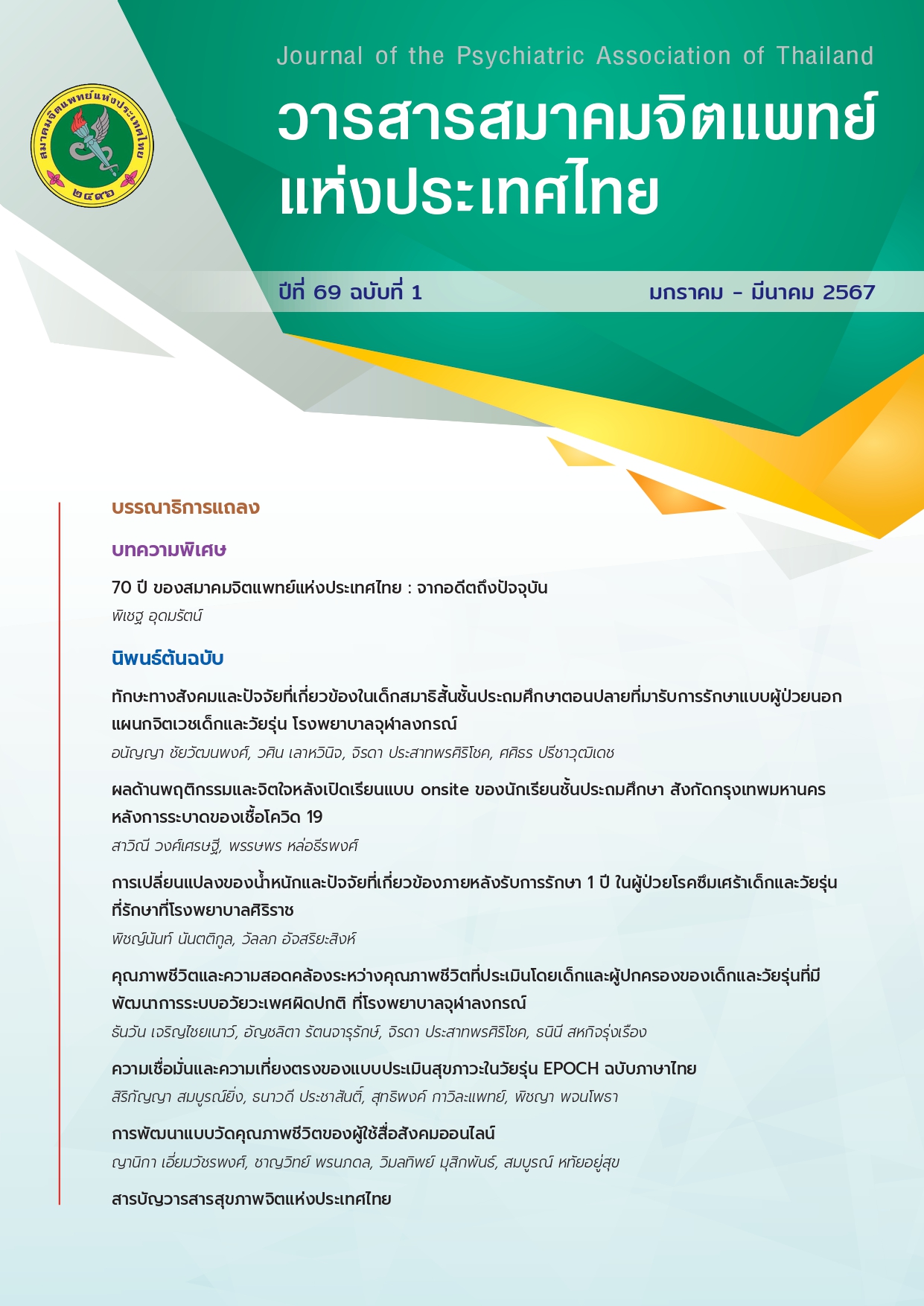The Development of Social Media Users' Quality of Life Scale
Main Article Content
Abstract
Objective: To develop the social media users’ quality of life scale. that has confidence in internal consistency and construct validity within acceptable level.
Methods: To develop the Social Media Users’ Quality of Life scale (SMQ), the questionnaire was originally composed of 36 questions, which were then reduced to 30 questions according to the expert’s suggestion. The questions were selected based on the value of communalities and the measurement of internal consistency by identifying Cronbach’s alpha coefficient. Moreover, the construct validity was measured through the exploratory factor analysis (EFA). The confirmatory factor analysis (CFA), and the latent profile analysis (LPA) were performed to categorize social media users according to their quality-of-life level.
Results: The research data collection was conducted online. The research samples accounted for 1,293 social media users aged 13 years and older (the mean age 38.17 years) in four generations. The questionnaire was modified to contain 27 questions based on the value of communalities. The exploratory factor analysis (EFA) revealed that all question items had loading factors of >0.4. The confirmatory factor analysis (CFA) indicated that the model fitted with the empirical data at χ2/df = 4.7, GFI= 0.92, CFI= 0.90, RMR= 0.04, RMSEA=0.05. The Cronbach’s alpha coefficients were measured in four domains: sociopsychological domain, relationship domain, mental and capacity support domain, and physical domain with values of 0.74, 0.82, 0.76 and 0.82 respectively. The Cronbach’s alpha coefficients of SMQ was 0.78. Latent profile analysis was achieved to provide appropriate cut-off points to categorize the level of quality of life of social media users by generations into 3 groups (low, moderate, and high groups).
Conclusion: The SMQ has quality in terms of validity and reliability is within acceptable level.
Article Details

This work is licensed under a Creative Commons Attribution-NonCommercial-NoDerivatives 4.0 International License.
Articles submitted for consideration must not have been previously published or accepted for publication in any other journal, and must not be under review by any other journal.
References
Ministry of Digital Economy and Society. Electronic transaction development agency. Thailand internet user behavior 2020. Bangkok: Electronic transaction development agency Ministry of Digital Economy and Society; 2020.
Ministry of Digital Economy and Society. Electronic transaction development agency. Thailand internet user profile 2018. Bangkok: Electronic transaction development agency Ministry of Digital Economy and Society; 2019.
Tepin A, Jumnianpol S. Factors affecting levels violence from social action to the different and counterattack through social media. SWTU 2018; 26: 251-74.
Supharakornsakul Y. Phetchabun hight school student’s behaviors in using online social networks and their impact. J SocHu UBU. 2017;8:53-71.
Juinam C, Chantaranamchoo N. The behaviors and effects of using social networks of the junior secondary school students in Sukhothai province. Veridian E-Journal, Silpakorn University. 2015;8:84-95.
Massayakong S. The quality of life in school of upper secondary students in Bangkok area [Thesis]. Bangkok: National Institute of Development Adminstration; 2011.
Thochampa S. School health. Phitsanulok: Naresuan University; 2019.
Vongsuphakphan P, Phanpanich P. The relationship between social media use with depression and anxiety among medical students at Udon Ratchathani University. JPMC 2022;39:24-32.
Chupradit P, Chupradit S. The influences of social media addiction on mental health status among university students in Thailand. Suthiparithat 2022;36:188-207.
Thongbang P. The relationship of social media addiction on ADHD among college students Sirinhorn public health Suphanburi. JYRI 2021;12:1-15.
Phanichsiri K, Tuntasood B. Social media addition and Attention Deficit and Hyperactivity Symptoms in school students in Bangkok. J Psychiatr Assoc Thailand 2016;61:191-204.
National Statistical Office. The population is separated by age nationwide [Internet]. Bangkok: National statistical office Thailand; 2019 [cited 2023/05/11]. Available from: https://catalog.nso.go.th/dataset/os_01_00001.
Mahidol University. Institute for population and social research. Thai people’s health 2016: Die well, the way you choose. Nakhon Pathom: Amarin; 2016.
Srisathitnarakun B. Development and validation of research instruments:psychometric properties. Bangkok: Chulalongkorn University; 2012.
Wareeprasirt N. Two-stage stratified surveys with probability proportional to size sampling of primary sampling units: a case stude survey tutoring of Thai student for speciality large-size secondary school [Thesis]. Bangkok: Chulalongkorn University; 2015.
Tavakol M, Dennick R. Making sense of Cronbach’s alpha. Int Med Educ. 2011;2:53-5.
Chaichanawirote U, Vantum C. Evaluation of content validity for research instrument. Journal of Nursing Sciences & Health 2017;11:105-11.
Sasong C. Strategic marketing alliance for self-reliance, sustainable for entrepreneurial community products in Muang district Mae Hong Son province [thesis]. Chiang Mai: Chiang Mai Rajabhat University; 2017.
Pinyo T. Techniques for interpreting the results of factor analysis in research work. Panyapiwat Journal 2018; 10:292-304.
Sakulsriprasert C. Confirmatory factor analysis. TH J CLI PSY 2013;44:1-16.
Sagoolsong P. Mixture structural equation modeling of factors influencing [Thesis}. Maha Sarakham: Rajabhat Maha Sarakham University; 2017.
Johannes B. A primer latent profile and latent class analysis [Internet]. Erfurt: ResearchGate; 2021 [cited 2023/05/11]. Available from: https://www.researchgate.net/publication/353424179_A_primer_to_latent_profile_and_latent_class_analysis.
Krishnamra S, Chanpen S, Tanthanawigrai P, Pornnoppadol C. The development of game addiction quality of life scales. J Psychiatr Assoc Thailand 2022; 67: 304-16.
Chanpen S, Pornnoppadol C, Vasupanrajit A, Dejatiwonges Q. An assessment of the validity and reliability of the Social Media Addiction Screening Scale (S-MASS). Siriraj Medical J 2023;75: 167-80.
National Cancer Institute. NCI dictionary of cancer terms [Internet]. United States: National Cancer Institute; [cited 2023/07/13]. Available from: https://www.cancer.gov/publications/dictionaries/cancer-terms/def/selection-bias#.
Shringarpure S, Xing EP. Effects of sample selection bias on the accuracy of population structure and ancestry inference. G3 (Bethesda) 2014;4:901-11.
Chintradecha P. Factors affecting internet addiction behavior by different generations in Bangkok. [Internet]. Bangkok: Centre for addiction studies; [cited 2023/08/17]. Available from: https://cads.in.th/cads/content?id=155.


